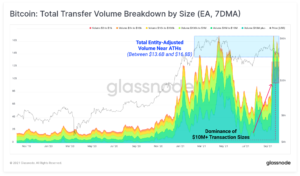October 13, 2021
 By: Wayne Duggan
By: Wayne Duggan
When it comes to trading options, understanding the daily market trading activity in a particular contract can be a helpful source of information. Stock traders often use trading volume as an indication of whether a technical breakout is legitimate or whether institutional investors are likely dabbling in a stock. Option traders have 2 metrics to use to understand daily trading activity: option volume and open interest.
Option Volume
In the stock market or the options market, volume is a measure of the total number of shares or contracts that have been traded that day. In the stock market, trading volume has no impact on the number of shares of stock that are being traded. However, in the options market, volume in a particular contract can either open or close out outstanding contracts.
Volume is what makes option prices move up or down. It is also a great way for option traders to gauge the liquidity of a particular contract. The higher the volume, the more liquidity the contract has. Higher liquidity means it is easier to enter and exit positions and the spread between the bid and ask prices will likely be lower.
Open Interest
Open interest is a metric that is unique to the options and futures markets. Unlike volume, open interest is a measure of the total number of open option contracts at a particular strike price and expiration date. Volume represents the total activity in a particular contract, but option interest tells traders what type of activity it is.
When new contracts are opened, open interest rises. When they are closed or liquidated, it falls. Rising open interest is a great indication that money is flowing into a particular contract. As a general rule of thumb, contracts with open interest of less than 500 contracts may not have enough liquidity to enter and exit easily.
Potential Trading Signals
Here’s an overview of some potential volume and open interest trading signals to watch out for:
- If prices are rising and call contract open interest is also rising, it could be a bullish signal that buyers are establishing new long positions.
- If prices are rising but call contract open interest is falling, it could be a bearish signal that traders are losing conviction in the bullish trend.
- If prices are falling but open interest in put contracts is rising, it could be a bearish signal that traders are opening new short positions.
- If prices are falling but call contract open interest is also falling, call holders may be getting forced out of their positions by margin calls, which could be a bearish short-term indicator but also an indication that a bottom could be near.
Active Trading with Lightspeed
Lightspeed provides professional traders with all the tools required to help them find success in stock trading, and we have been developing and honing our active trader platform to offer an optimal user experience. With the intuitive interface layouts and institutional quality stock and options scanners, we aim to help traders reach their goals, no matter what their strategy is. We also offer our clients some of the lowest trading fees in the industry.
For more information on a professional trading platform with Lightspeed, please call us at 1-888-577-3123, request a demo, or to open an account.
Lightspeed Financial Services Group LLC is not affiliated with these
third-party market commentators/educators or service providers. Data,
information, and material (“content”) are provided for informational and
educational purposes only. This content neither is, nor should be construed as
an offer, solicitation, or recommendation to buy or sell any securities or
contracts. Any investment decisions made by the user through the use of such
content is solely based on the users independent analysis taking into
consideration your financial circumstances, investment objectives, and risk
tolerance. Lightspeed Financial Services Group LLC does not endorse, offer nor
recommend any of the services or commentary provided by any of the market
commentators/educators or service providers and any information used to execute
any trading strategies are solely based on the independent analysis of the user.
You may also be interested in…
- All
- analysis
- bearish
- breakout
- Bullish
- buy
- call
- clients
- closed
- Commentary
- content
- contract
- contracts
- data
- day
- educational
- Exit
- experience
- financial
- financial services
- Futures
- General
- Goals
- great
- Group
- HTTPS
- Impact
- industry
- information
- Institutional
- institutional investors
- interest
- investment
- Investors
- IT
- lightspeed
- Liquidity
- LLC
- Long
- Market
- Markets
- measure
- Metrics
- money
- move
- Near
- offer
- open
- Option
- Options
- price
- quality
- Risk
- Securities
- sell
- Services
- Shares
- Short
- spread
- stock
- stock market
- stock trading
- Strategy
- success
- Technical
- tells
- tolerance
- trader
- Traders
- Trading
- Trading Strategies
- us
- users
- volume
- Watch



